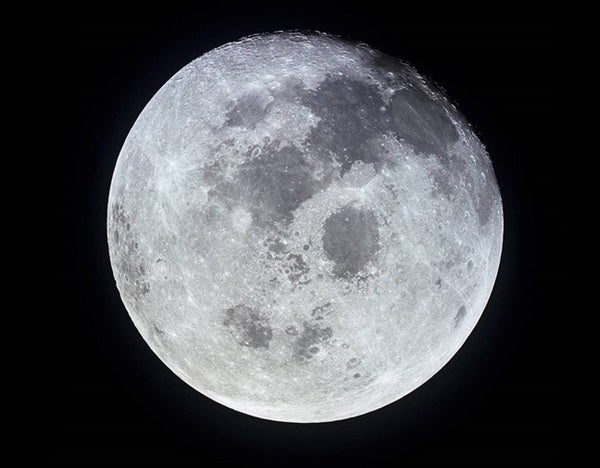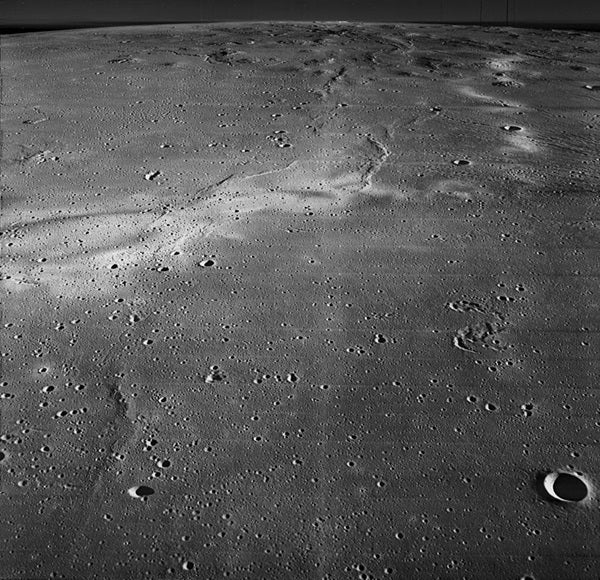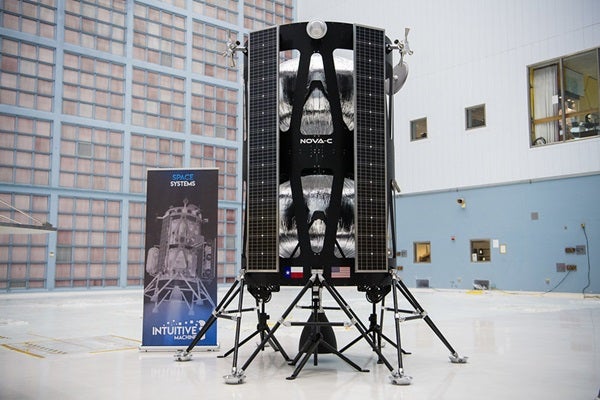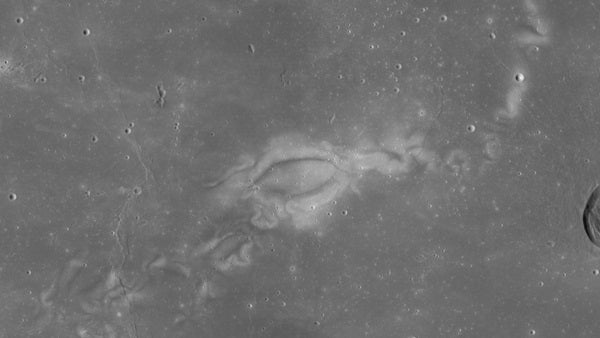Some lunar scientists call it the most beautiful thing on the Moon: Reiner Gamma, a white, swirling, paisley-like pattern seemingly painted on the far reaches the Moon’s northwest quadrant. It’s a mystery, one visible through virtually any backyard telescope. And no one knows how it or other so-called lunar swirls got there.
Reiner Gamma is the most prominent of this strange class of lunar features. Lacking surface definition — swirls cast no shadows — it has baffled astronomers for a long time. Thomas Gwyn Elger wrote in 1895 that Reiner Gamma consisted of “six ill-defined white spots of doubtful nature…there is a large white marking, resembling a ‘[mouth] harp’ in shape.” Nineteenth-century selenographers Wilhelm Beer and Johann Mädler thought it a plateau. So did British lunar expert Edmund Neison. Some early maps mistakenly identified the feature as a crater.
Modern science suggests any number of possibilities, all tied to the creation of a strong, highly local magnetic field that keeps the surface from weathering due to the solar wind. But the Moon has no global magnetic field. So, just why Reiner Gamma and other such swirls are associated with local fields is still unclear.
But it’s about to get clearer.
Enter Lunar Vertex
David Blewett of the Johns Hopkins Applied Physics Laboratory (APL) in Laurel, Maryland, became intrigued by lunar swirls while in graduate school but didn’t get to work on them until after finishing his doctorate. He is enthusiastic about their beauty and their scientific potential.
“The lunar magnetic anomalies/swirls are wonderful natural laboratories that lie at the intersection of geoscience with space plasma physics,” he tells Astronomy. “There aren’t a lot of situations where ‘sky science’ and geoscience come together, but that’s what you’ve got in the lunar swirls.”
Blewett spent years in “advocacy of the scientific wonderfulness” of lunar swirls, an effort culminating in NASA’s selection in June of the low-cost but ambitious Lunar Vertex mission through the Commercial Lunar Payload Services (CLPS) program. (“Vertex” comes from the Latin for “whirl” or “eddy.”)
Lunar Vertex is the first of the PRISM-class missions, where PRISM stands for Payloads and Research Investigations on the Surface of the Moon. Blewett is principal investigator of the mission, which will be run by APL. But Lunar Vertex is an international effort, with contributions from Canadensys (an aerospace company near Toronto), which is building the rover’s multispectral microscope, as well as researchers in Canada, France, and Sweden.
Intuitive Machines, which currently has several CLPS contracts, was awarded nearly $78 million in November to provide lander service via its Nova-C Lander.
This 2024 mission is set to land where no one else has put down before: Right in the midst of Reiner Gamma. The lander will release a low-slung rover, built by Lunar Outpost in Boulder, Colorado, and both lander and rover will take magnetic and spectral measurements to determine the origin of lunar swirls — whether they formed when cometary debris struck the surface or through some other process. Lunar Vertex will have just one lunar day — that’s 14 Earth days — to solve the puzzle. The solar-powered mission won’t survive the frigid lunar night.
The impact ideas
But where do lunar swirls come from? Blewett says there are three main hypotheses to explain the formation of lunar swirls.
The first two ideas posit external amplification of magnetic fields during impacts on the Moon, either from the gas and dust of a comet’s coma or the cloud of vapor and plasma generated by a large, basin-sized impact crater. Such large impacts throw up material, called ejecta, which, in the Moon’s low gravity, can travel vast distances and converge on the impact’s antipodal point on the opposite side of the Moon. During its journey, the material gets magnetized through “complicated means,” says Blewett.
Peter Schultz and Leonard Srnka proposed in a 1980 Nature paper that a comet between 650 and 1,640 feet (200 to 500 meters) in diameter — and possibly consisting of two nucleus fragments — hit the Moon, creating Reiner Gamma. They even found candidate impact sites for their proposed double impactor: Goddard A and the edge of the crater O’ Day. Goddard and its satellite craters are on the Moon’s eastern limb in Mare Marginis, while O’Day is on the farside. But if comets are responsible for this and other swirls, why aren’t there more of them? After all, as lunar researcher and author Charles Wood writes, “Various studies have shown that impacts from comets should be just as common as those from asteroids.” Additionally, one study failed to show spectral evidence at Reiner Gamma of materials usually associated with comets.
But if swirls are associated with impact eject from antipodal impacts, why isn’t Reiner Gamma antipodal to such an impact? One suggestion from Lon Hood at the University of Arizona’s Lunar and Planetary Laboratory and others is that Reiner Gamma may have formed from ejecta from the crater Cavalerius. But it might also be a consequence of the huge Mare Imbrium impact nearly 4 billion years ago, an idea that Hood supports. As it happens, Apollo impact breccias are the most magnetic of lunar samples, showing that impacts can induce magnetism.
Referencing a 2019 paper he co-authored in Journal of Geophysical Research: Planets, Hood suspects that most lunar magnetic anomalies were caused by iron-rich ejecta produced by the impactor that created the basin. For example, “the Imbrium basin is the youngest large basin on the near side of the Moon and many of the magnetic anomalies (including Reiner Gamma) are aligned radial to this basin,” he says. So instead of invoking an antipodal impact, his contention is that ejecta — now buried —deposited by the Imbrium explosion is the cause of Reiner Gamma’s mysterious white markings.
Hood also says that “the iron-enriched ejecta from Imbrium converged on the lunar farside at the antipode to produce the largest group of strong anomalies on the Moon. Similar concentrations of anomalies are found opposite to several other young lunar basins.” The pieces of ejecta would have been so big that they would have cooled slowly, “while they were being magnetized,” Hood adds. And any pre-existing magnetic field inside the Moon would have further magnetized the ejecta.
Hood says that Reiner Gamma “is perhaps the most enigmatic feature on the Moon and its origin will probably not be fully resolved for a long time.” That’s because, he says, the feature presents two separate problems: the origin of its magnetic anomaly and the origin of its light-colored curvilinear albedo markings. “The albedo markings are probably a secondary consequence of the magnetic anomaly,” Hood adds, “but exactly how … is a continuing mystery.”
But the Lunar Vertex mission will definitely help solve this enigma, he says.
Inside job
But there’s a third possibility for the Reiner Gamma magnetic field — and others like it — that doesn’t involve impacts at all. This idea is an endogenic, or internal, possibility, whereby lava cooled on or near the surface at a time when the Moon had its own global magnetic field. As the molten rock solidified, it preserved a record of the field even as the lunar interior cooled and the dynamo that generated the field died.
Douglas J. Hemingway and Sonia M. Tikoo suggested in 2018 that “heating associated with magmatic activity” within the Moon might have ramped up localized magnetic fields. “We suggest,” they wrote, “that these rocks were likely injected into the crust in the form of dikes and subsurface channels of flowing lava and that they cooled slowly, leading to enhancement of their metal content and enabling the rocks to capture a stable record of the Moon’s ancient global magnetic field.”
If the magnetic anomalies are endogenic, it raises questions about the volcanic and geochemical processes that produced rocks with high abundances of metallic iron, Blewett suggests. What’s more, nothing in the Apollo, Luna, or Chang’e sample collections have such compositions.
Whatever their cause, it seems that localized magnetic fields shield the surface from the normal space weathering that darkens the regolith in non-magnetic areas. It’s also possible that local electromagnetic effects cause the high albedo, or reflectance, of the swirl by prompting the movement of electrostatically charged dust over the swirls.
How strong are those fields? Blewett says, “We don’t actually know the strength of the local field down on the ground within one of the magnetic anomalies. That will be one of the major contributions of Lunar Vertex! However,” he adds, “it is unlikely that the fields are strong enough to protect the surface (or people or equipment) from dangerous high-energy radiation like cosmic rays or solar energetic particles.”
See swirls for yourself
Amateur astronomers don’t have to wait for 2024 to explore lunar swirls. Reiner Gamma is the most impressive and easily located, but there are four other swirls that amateurs can look for on the nearside, according to John Moore’s Features of the Near Side of the Moon. On the eastern limb near the crater Goddard, the Mare Marginis swirls are wispy and less concentrated than Reiner Gamma. A good libration helps bring them in view. In the lunar southwest, north and east of the crater Sirsalis, is a swirl that seems to have a darker twin next to it. Not too far away, east of the crater Lohrmann, is another swirl that Moore says looks like an octopus and Blewett calls “a little swirlette shaped liked a capital omega.” The hardest to spot may be a bright loop between Airy and Parrot C.
Blewett also adds to the list “a diffuse bright spot between craters Dollond E and Descartes C.” This is south of where Apollo 16 landed, in an area with a strong magnetic field.
Enjoy hunting for and studying lunar swirls. And stayed tuned, as Lunar Vertex soon sheds some light on these enduring mysteries.
Astronomy will be covering the Lunar Vertex mission from start to finish, with upcoming articles on rover construction and testing, the launch, landing, and the exciting return of data from this enigmatic part of the lunar surface.













